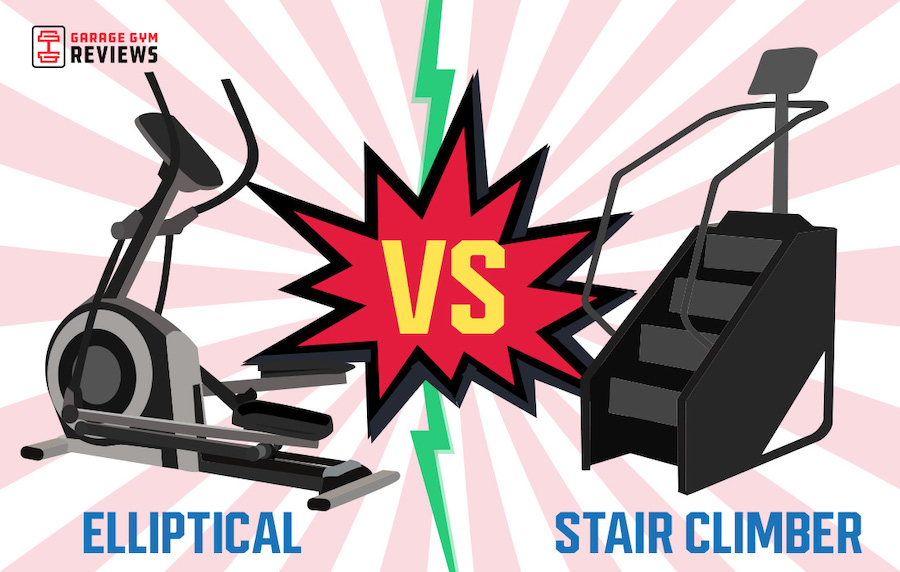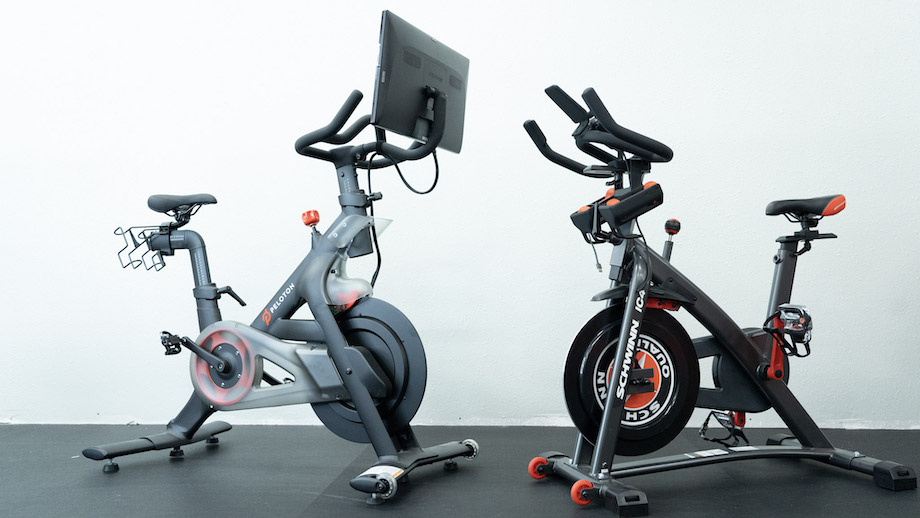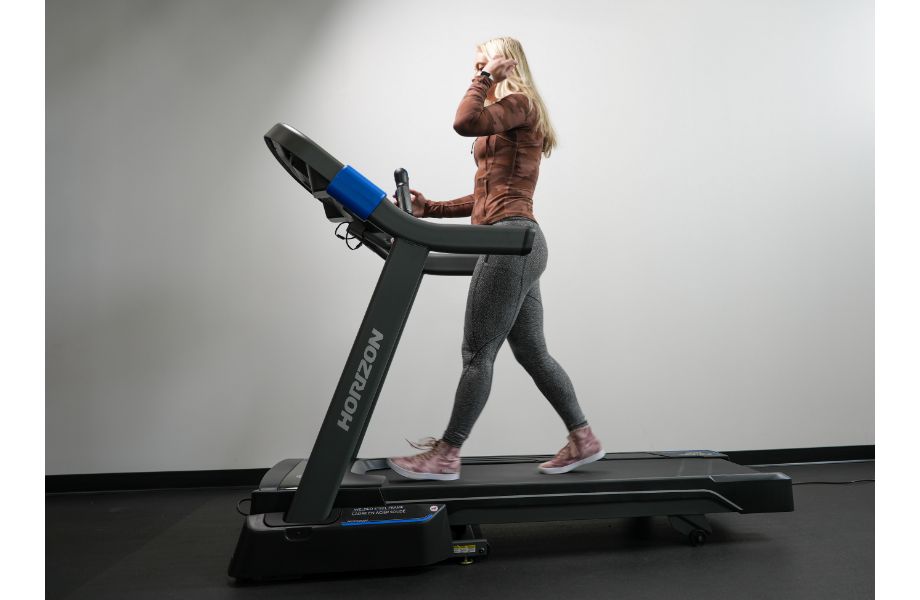If you’re adding a cardio machine to your home gym, chances are you’ll have to weigh a stair climber vs elliptical. These two popular machines may have a similar calorie burn, but how they do that is different. Some people may prefer lower body-focused stair-climbing, while others may prefer a more low-impact option.
The stair climber targets the lower body, toning and sculpting the quads and glutes. Ellipticals offer a low-impact workout that can activate the upper and lower body, including the abs. Both increase your heart rate, and both can burn through calories to enhance weight loss. You’ll need to consider your goals and what you hope to accomplish in your home gym to decide which one is best for you.
What’s a Stair Climber?
Stair climbers are stationary cardio machines that you find in almost every globo gym, and they’re basically a revolving staircase. The burn you get in your quads and glutes when trudging up several flights of stairs is the kind of workout you can expect for your leg muscles with a stair climber.
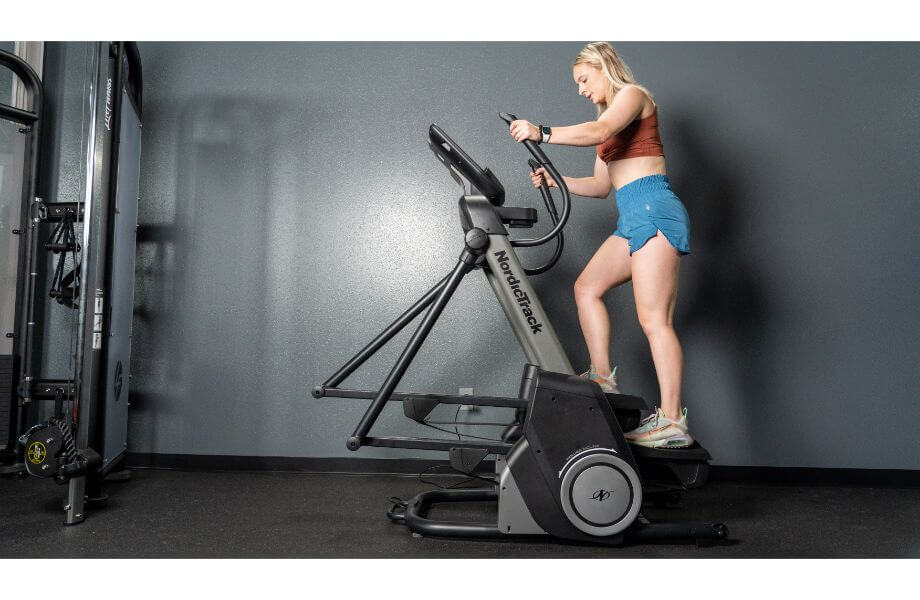
You can change the speed at which the stairs revolve to make the workout easier or harder. A change in foot placement can also alter the muscles activated to change up your routine. They’re a good option to burn fat and target your leg muscles.
Benefits of Stair Climbers
Stair climbers have numerous benefits, including:
Improved Cardiovascular Fitness
Climbing stairs gets your heart, lungs, and circulatory system working, making stair climbers an excellent form of cardiovascular exercise. Your heart and breathing rate increase to supply your legs with the oxygen they need to keep up your pace.
Like other forms of aerobic exercise, a stair climber that is regularly used as part of your fitness program comes with many health benefits like reducing your chances of stroke, heart attack, and high blood pressure.
Sculpts the Lower Body
Stair climbers work all of your major lower-body muscle groups, including the quads, glutes, hamstrings, and calves. You might feel a more intense workout and burn in one or two muscle groups. The legs can work hard enough on a stair climber to make it a muscle-building tool, too.
Many people find that their quads and glutes get toned and defined with regular stair climber use. If you take the steps on your toes, you could see some added definition in your calves. Your speed and intensity will influence how and where you see your strength and definition develop.
Strengthens Your Bones
As you age, your bone density begins to decline, which can eventually lead to diseases like osteoporosis. Weight-bearing exercises, like climbing stairs, require your bones (and muscles, of course) to work harder than they do when you’re sedentary. That use, overload, and stress stimulate muscular and skeletal strength and stability.
Supports Weight Management
Stair climbers help you burn extra calories. Consequently, they can be an integral part of maintaining a healthy weight. Depending on the speed settings, you can burn through a substantial amount of calories in a relatively short amount of time.
What’s an Elliptical?
The elliptical is one of the most popular cardio machines on the market next to treadmills, and you can buy one at a variety of retailers. An elliptical machine has two suspended pedals, one for each foot, and handlebars for your hands. As you step forward with one foot and press the hand on the opposite side, your momentum gets the machine going and it feels similar to walking or running.
RELATED: Elliptical vs Treadmill
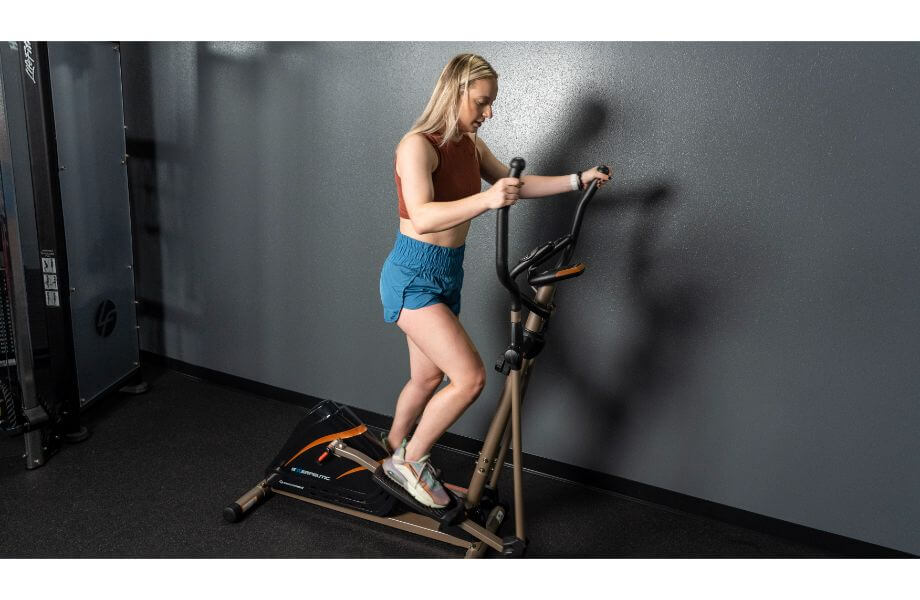
Ellipticals mimic walking and running but are low-impact, taking stress off of your hips, knees, and ankles. They can also be used for full-body workouts because the handlebars provide an upper-body workout. However, most machines have additional stationary handles if you choose to focus on the lower body.
Benefits of Ellipticals
Ellipticals also have numerous elliptical benefits, including:
Gives You a Cardiovascular Workout
Ellipticals quickly activate the heart, lungs, and circulatory system, especially if you use the handles for a full-body workout. You can adjust the resistance of the machine or increase your speed to increase the workout intensity. That also lets you do a different type of workout than just steady-state cardio, like high-intensity interval training (HIIT elliptical workout).
Provides Low-Impact Cardio
Running and stair climbing may be excellent cardio exercises, but they put a lot of stress on your joints. Repetitive, high-impact exercises can cause or aggravate injuries. Ellipticals are a great alternative if you’re recovering from an injury or if you have joint issues because the elliptical gliding motion reduces impact. You can get a workout that’s equivalent to running without banging up your body.
It’s a Full-Body Workout
The more muscle groups you work at once, the more calories you burn. Elliptical workouts activate major muscle groups in the upper and lower body, thanks to the handlebars. However, the depth and intensity of that full-body workout are up to you. You can put your hands on top of the handles and let them ride along while your legs do all the work, or you can push and pull with your arms to work the upper and lower body equally.
Cost
How much do stair climbers and ellipticals cost? Both of these cardio machines come in a wide price range that falls between $200 on the budget end, to well over $2,000 on the high end. You’ll find more ellipticals at the lower end of the price range than stair climbers. Many of the stair climbers that fall between $200 and $500 actually look and function more similarly to an elliptical than the revolving stair climbers you find at the gym.
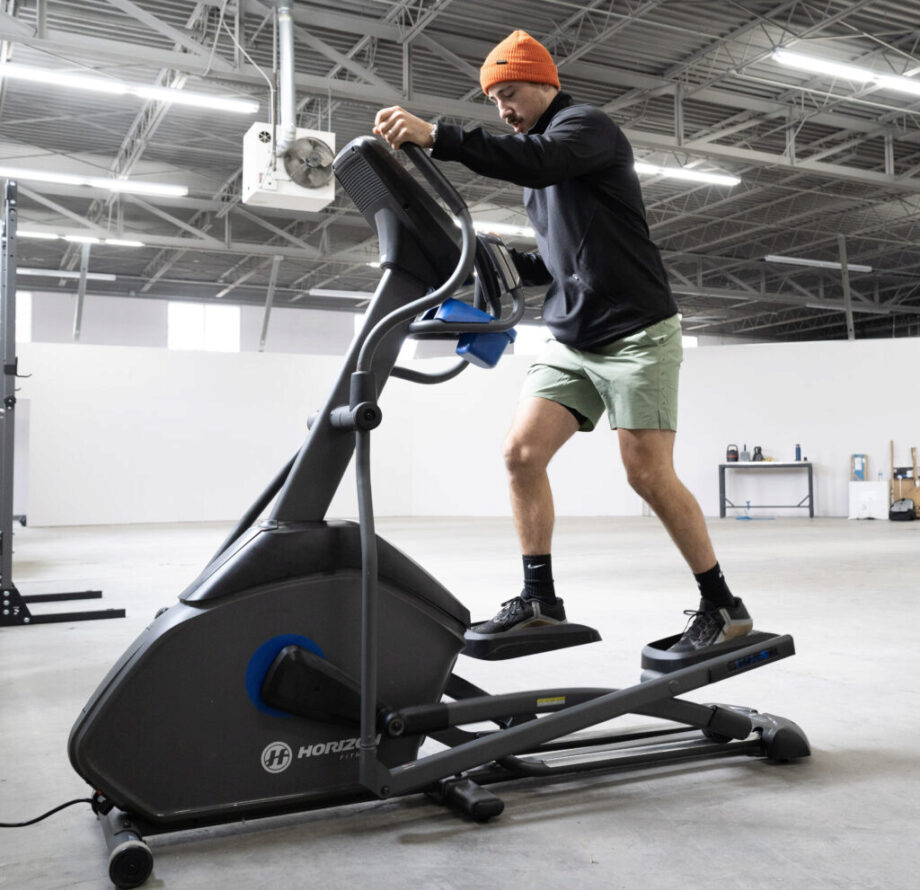
However, if you’re going to use an elliptical or stair climber for regular use, you probably want to invest between $1,000 to $1,500 for a sturdy, durable model. At over $1,500, you’ll find ellipticals and stair climbers with more preset programs and resistance settings. Of course, you could also go with the ultimate investment and splurge for a $4,000-to-$5,000 professional elliptical machine or stair climber just like the ones at the gym.
Burning Calories
Before we jump into how many calories you burn on ellipticals and stair climbers, there are a few things to consider.
- Your body weight affects how many calories you burn. The heavier you are, the more calories you’ll blast during your workout.
- The higher the speed and resistance level, the more calories you burn in a single session.
- Your fitness level affects how many calories you burn. The fitter you are, the fewer calories you may burn in a session because your body is more adept at cardio. (You can keep up your calorie burn by varying the types of cardio equipment and exercises you use.)
- Your age and gender will affect the number of calories you burn. Men burn more calories than women because of their higher muscle mass.
That said, according to Harvard Health, a 155-pound person will burn about 324 calories from 30 minutes on an elliptical. Conversely, that same 155-pound person would burn about 216 calories from 30 minutes on a stair climber. This makes sense, as ellipticals are more of a full-body workout, and odds are, you’ll be able to move faster on an elliptical than a stair climber.
Programs Available
When you’re looking at elliptical vs stair climber preset programs, ellipticals typically offer a greater variety because you can adjust the resistance and the speed. While budget ellipticals may be lacking on preset programs, the average mid-range elliptical machine can have anywhere from five to 10 that range from rolling hills and miscellaneous hills to intervals and HIIT programs.
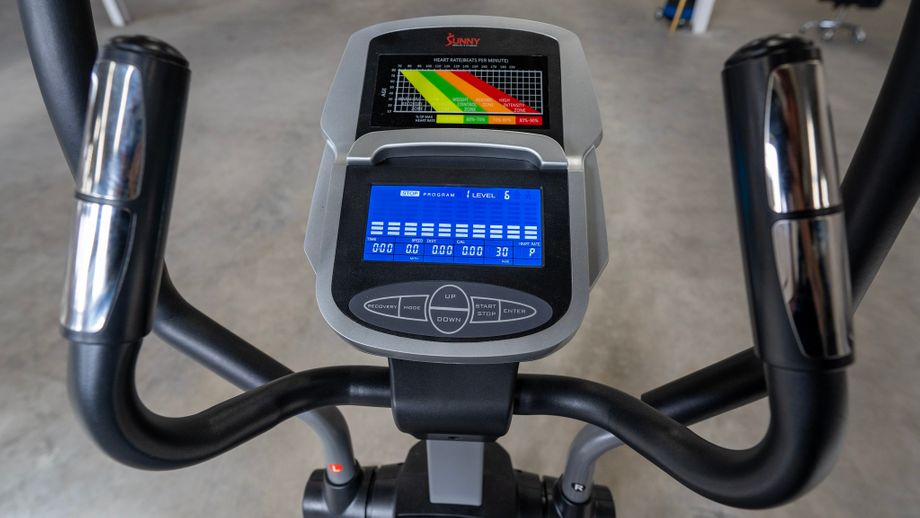
Stair climbers are more limited because speed is the only way to increase or decrease the intensity. Preset programs may have several intervals or HIIT presets, but that’s about it because the speed and time you go at those speeds is the only way to increase the intensity.
Stair Climber vs Elliptical Muscles Worked
Ellipticals engage a wide range of muscles, including the:
- Rhomboids
- Trapezius
- Pectorals
- Biceps
- Deltoids
- Rectus abdominis
- Quadriceps
- Glutes
- Hamstrings
- Calves
Some of these groups might be more or less activated depending on the angle of the pedals, step length, and intensity. Your shoulder muscles and upper back will get a better workout the harder you push and pull with your arms.
Stair climbers put the lower body to the test, activating the:
- Quads
- Glutes
- Hamstrings
- Calves
- Abdominals
How and where you step on the stair climber steps can activate different muscle groups. Don’t be afraid to try stepping wide or skipping a step to change up the intensity.
Stair Climber vs Elliptical Joint Impact
Knee, ankle, and hip pain and irritation keep many people from getting the exercise they need. If you have joint issues, opt for an elliptical. Ellipticals offer safe, low-impact cardio that works your whole body without joint damage.
Stair climbers put more stress on the lower body, especially the knees. If you have lower-body joint issues or injury, a different form of cardio will be easier on your body. However, if you’re focusing on your lower body and you don’t have joint problems or injuries, a stair climber is an excellent piece of gym equipment.
Stair Climber vs Elliptical Final Verdict
Your personal preferences and fitness goals all influence the cardio machine that’s right for you. Ellipticals and stair climbers are good ways to get your heart pumping and calories burning.
Stair climbers lean more toward weight-bearing and lower body than an elliptical, but ellipticals activate most of the major muscle groups, including your core muscles. Your calorie burn will be higher on an elliptical. It comes down to personal preferences. However, you might purchase an elliptical if you:
- Need a low-impact alternative to running
- Prefer a full-body workout
- Have joint or lower body injuries or issues
You might opt for a stair climber if you:
- Are focused on lower-body strength
- Want greater weight-bearing exercise
- Want to tone and sculpt your glutes and quads
Stair Climber vs Elliptical FAQs
Is a stair climber better than an elliptical?
Stair climbers aren’t better than ellipticals, and ellipticals aren’t necessarily better than stair climbers. It depends on your fitness goals, fitness levels, and any injuries or medical conditions you have. Ellipticals provide a full-body workout, with greater workout variety in models that have preset programs. Stair climbers focus on cardio and strength using the lower body.
What’s the difference between a climber and an elliptical?
A climber is a revolving stair stepper, like a Stairmaster. An elliptical has two suspended pedals with moving handlebars to engage both the upper and lower body.
What is the best exercise machine for a cardio workout?
When you’re looking at the best exercise machine for a cardio workout, you’re typically looking at treadmill vs elliptical vs stair climber because they’re the most popular options.
Ellipticals provide a full-body workout and are easy on the joints. Stair climbers activate the large muscles of the lower body, building strength while improving cardiovascular health. Treadmills can provide an effective cardio workout as well, but tend to be higher-impact, just like stair climbers. It all comes down to your individual limitations and preferences.
Do stairs help build your glutes?
Stairs most definitely help build your glutes. The glutes extend, rotate, abduct, and adduct your leg. They’re an integral part of your ability to climb stairs, so a stair climber will strengthen and define the glutes.


